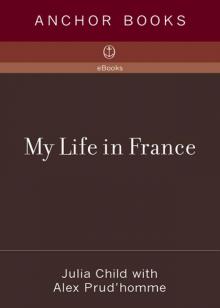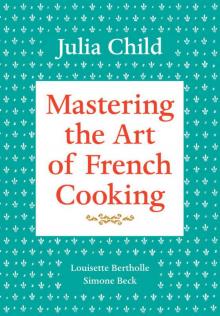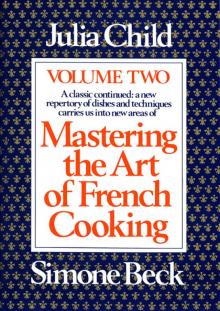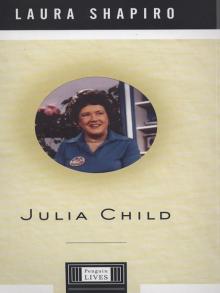- Home
- Julia Child
Mastering the Art of French Cooking, Volume 1 Page 2
Mastering the Art of French Cooking, Volume 1 Read online
Page 2
This fortieth anniversary edition is essentially the same book that first came out in 1961, which was reedited in 1983 to bring it up to date, especially because the food processor had appeared in American kitchens. Before the arrival of that incomparable machine, we did have the electric blender and heavy duty mixer, but the food processor revolutionized many otherwise almost hopelessly onerous tasks such as the making of fish mousses and quenelles. It simplified such often tricky procedures as pie doughs, and made fast work of routine dog work like mushroom dicing, cheese grating, bread crumbing, and onion slicing.
Mastering the Art of French Cooking is just what the title says. It is how to produce really wonderful food—food that tastes good, looks good, and is a delight to eat. That doesn’t mean it has to be fancy cooking, although it can be as elaborate as you wish. It simply means careful cooking, la cuisine soignée, by people who know what they are doing. According to me, if you are thoroughly skilled in French techniques, because the repertoire is so vast, you have the background for almost any type of cuisine. In other words, and at the risk of creating mayhem in some circles, I think you are better as an Italian, Mexican, or even Chinese cook when you have a solid French foundation.
There is certainly nothing particularly difficult about the basics. It is a question of getting started, and of learning how to pick the best and freshest ingredients, and of knowing, reading, seeing, or being shown how to hold the knife, chop the onion, peel the asparagus, make the butter and flour roux, and above all of taking it seriously. If you are not used to slicing potatoes by hand or peeling, seeding, and juicing tomatoes you will be slow and a little clumsy at first. However, once you decide you are really going to do it right, you will find that with surprisingly little practice you are mastering the techniques.
The recipes here are thoroughly detailed since this is a teaching book. How about eight pages on making a simple omelet? You’ve got all the directions and if you can read, you can cook. You are learning by doing, and if the dish is to turn out as it should, no essential direction can be left out. How far, for instance, should the chicken be from the heat element when you are broiling it? Five to six inches. Or how fast should the oil be beaten in when you are making the garlic-and-mustard coating for a roast leg of lamb? Drop by drop. Every detail takes up space, making some actually quite simple recipes look long.
Certainly one of the important requirements for learning how to cook is that you also learn how to eat. If you don’t know how an especially fine dish is supposed to taste, how can you produce it? Just like becoming an expert in wine—you learn by drinking it, the best you can afford—you learn about great food by finding the best there is, whether simple or luxurious. Then you savor it, analyze it, and discuss it with your companions, and you compare it with other experiences.
In the 1950s, when this book was conceived, and on into the 1980s, we in this country pretty well ate as we liked with little or no attention paid to lashings of the best butter and the heaviest cream. You will note this indulgence here, especially in sauces, where you reduce them with cream or where you swirl in fresh butter a generous tablespoon at a time to render them smooth, shining, and luscious. I have not changed any of these original proportions or directions, because this is the way the dishes were conceived. However, do use your own judgment as to how much or how little of the enrichments you care to use, since the amounts will not interfere with the basic recipe. In my case, for instance, I have been known to substitute a modest teaspoon for the generous tablespoon.
Finally, I do think the way to a full and healthy life is to adopt the sensible system of “small helpings, no seconds, no snacking, and a little bit of everything.” Above all—have a good time!
What a happy task you have set for yourself! The pleasures of the table are infinite. Toujours bon appétit!
THE STORY OF “MASTERING” AT KNOPF
by Judith Jones
IN JUNE OF 1960 a hefty manuscript—a treatise on French cooking by an American woman, Julia Child, and two French ladies, Simone Beck and Louisette Bertholle—landed on my desk. I had been an editor at Knopf for about three years, working primarily on translations of French books. But it was no secret that I had a passion for French cooking, so I was the logical person to read it.
The manuscript had been sent down from Cambridge by Avis de Voto, who worked as a scout for the Knopfs. She was the wife of the historian and writer Bernard de Voto, who had had a lively transatlantic correspondence with Julia on the subject of knives as a result of a piece he had done in The Atlantic Monthly. Avis soon became involved when she heard that Julia was working on a cookbook in Paris with Mesdames Beck and Bertholle, and she offered to try to find an American publisher. Her first submission met rejection, the publisher’s comment being, Why would any American want to know this much about French cooking?
Well, it so happened that I did. As I turned the pages of this manuscript, I felt that my prayers had been answered. I had lived in Paris for three and a half years—at just about the same time the Childs were there, although our paths had never crossed—and most of what I learned then about cooking I absorbed from the butcher, the baker, the greengrocer, and the fishmonger. I would ask questions of them all, and then back in my tiny kitchen I would try to remember what the butcher’s wife had told me about making frites or the poissonière about sautéing a dorade.
When I returned to the States, I realized how totally inadequate the few books that dealt with French food really were. They were simply compendiums of shorthand recipes and there was no effort to instruct the home cook. Techniques were not explained, proper ingredients were not discussed, and there was no indication in a recipe of what to expect and how to rectify mistakes. So the home cook, particularly an American home cook, was flying blind.
Yet here were all the answers. I pored over the recipe, for instance, for a beef stew and learned the right cuts of meat for braising, the correct fat to use (one that would not burn), the importance of drying the meat and browning it in batches, the secret of the herb bouquet, the value of sautéing the garnish of onions and mushrooms separately. I ran home to make the recipe—and my first bite told me that I had finally produced an authentic French boeuf bourguignon—as good as one I could get in Paris. This, I was convinced, was a revolutionary cookbook, and if I was so smitten, certainly others would be.
Below is the report I wrote at the time on “The French Cookbook,” which I hoped would convince the Knopfs that this book would be a credit to their imprint. I also enlisted the help of a senior colleague, Angus Cameron. He had been an editor at Bobbs-Merrill when Joy of Cooking was published and he loved to say that he had enough larceny in his soul to know just how to pitch a book. So his report, I’m convinced, did the trick (also included is his final paragraph).
The rest is history. In the fall of 1961 we published Mastering the Art of French Cooking (incidentally, Alfred Knopf, when I told him the title we had settled on, said if anyone would buy a book by that title, he would eat his hat), and after Craig Claiborne pronounced the book a classic, the book went into a second printing before Christmas. Of course, when Julia went on television the following summer as the French Chef all of America fell in love with her. But everything she taught on camera was grounded in this seminal book—understand what you are cooking, do it with care, use the right ingredients and the proper equipment, and, above all, enjoy yourself.
My Report on French Cookbook by Julia Child,
Simone Beck, and Louisette Bertholle
I’ve had this French cookbook for Americans for almost two months now, have read it through, tried innumerable recipes, some simple and some challenging, and I think it’s not only first-rate but unique. I don’t know of another book that succeeds so well in defining and translating for Americans the secrets of French cuisine. The reason? Because the authors emphasize technique—not the number of recipes they can cram into a volume, nor the exotic nature of the dishes. Reading and studying this book seems to me a
s good as taking a basic course at the Cordon Bleu. Actually it’s better than that because the authors’ whole focus is on how to translate the tricks learned to the problems that confront you at home (i.e., the differences in meat cuts, utensils, materials). It is not a book for the lazy but for the cook who wants to improve, to take that giant step from fair-to-good accomplishment to that subtle perfection that makes French cooking an art. I swear that I learned something from this manuscript every few pages.
As to recipes, they have very intelligently selected the dishes that are really the backbone of the classic cuisine. (Attached is the table of contents.) The approach is to introduce the general subject first: what to look for in buying, best utensil to use, timing, testing for doneness, tricks to improve. Then there is usually a master recipe, presented in painstaking detail, followed by variations, different choices of sauces for embellishing the same dish. There is a good deal of text devoted not to cuisine lore but to practical detail; you are seldom directed to do something without being told why. The authors are perfectionists, opinionated, and culinary snobs in the best sense—that is, they will approve of a frozen short cut, when time demands it, but they tell you how to add some tastiness to the packaged good. They also give of themselves; their dos and don’ts are not arbitrary but they stress that their method is one that they have arrived at through experimentation.
Finally, I do not believe that this book will in any way hurt others, such as Donon’s Classic French Cuisine, on our list. The fact is that it enhances other French cookery books because one can apply techniques learned in it in order to use effectively the recipes offered so sketchily, by comparison, in all the other books, and it should be so promoted. I think this book will become a classic.
From Angus Cameron’s Report
This manuscript is an astonishing achievement and there is simply nothing like it. Cooks will know this by word of mouth very soon, I’m sure. I think we should have this confidence and venture it with the knowledge that others will have to look to their laurels when this one is available.
THE RECEPTION OF THE BOOK IN 1961
“Probably the most comprehensive, laudable, and monumental work on [French cuisine] was published this week, and it will probably remain as the definitive work for nonprofessionals … [It is] a masterpiece.”
—Craig Claiborne’s review in the New York
Times when Mastering the Art of French Cooking
was first published on October 16, 1961
“I only wish that I had written it myself.”
—James Beard
THE INFLUENCE OF “MASTERING”
OVER THE LAST FORTY YEARS
“Julia Child paved the way for Chez Panisse and so many others by demystifying French food and by reconnecting pleasure and delight with cooking and eating at the table. She brought forth a culture of American ingredients and gave us all the confidence to cook with them in the pursuit of flavor.”
—Alice Waters, Chez Panisse
“It’s hard to believe that forty years have passed since wonderful Julia freed the American public from their fears of cooking French. By doing so, she greatly expanded the audience for all serious food writers. Her demystification prepared that public for the rest of us. I believe that the television shows based on that landmark book did even more to encourage reluctant cooks to try their hands … much to our benefit.”
—Mimi Sheraton
“Julia Child was the opposite of the mid-western, mid-American, mid-century, middlebrow food I grew up on. She was also the antithesis of the women I saw cooking, all of whom had serious June Lockhart aspirations. Julia, on the other hand, turned imperfection into a hoot and a holler. She seemed to teach cooking, but she was really celebrating the human, with all its flaws and appetites. I was a goner the first time I heard her voice, which happened to be while I was a cook in a feminist restaurant that served nonviolent cuisine. If it weren’t for Julia Child, I might never have moved past brown rice and tofu. Worse, I might still be afraid of being less than perfect. Cooking through Mastering the Art of French Cooking, I learned how to cook without fear because I got over fearing failure. Julia Child gave an entire generation this gift—and dinner, too.”
—Molly O’Neill
“The more I have come to know Julia over the years, the more I realize that Julia, the friend, the author, the TV superstar, are one and the same. Mastering the Art of French Cooking was one of the most influential books in twentieth-century America. It was the book, more than any other, that, combined with her television shows, taught Americans how to cook simple and not-so-simple classic French dishes. Like Julia herself, the book is a classic, a catalyst in the refinement of American culture. My own copy of Volume One (a 1975 edition) is so worn that the duct tape holding it together looks natural. Although this book wasn’t intended for professionals, I knew a few young American chefs who, like me, referred to it often because Julia was a trusted secret mentor, and her recipes were clear-cut and dependable. They still are.”
—Jasper White, Summer Shack
“The recipes in Mastering the Art of French Cooking are classics—dishes that taste so good because the ingredients work together with no need for gimmicks. Julia’s opening sentence in the foreword to the ’83 edition couldn’t be more true: ‘This is a book for the American cook who can be unconcerned on occasion with budgets, waistlines, time schedules … or anything else which might interfere with the enjoyment of something wonderful to eat [emphasis mine].’
I remember the excitement and pride I felt when I first served Julia’s Veal Orloff. The Soubise, on its own, that glorious mixture of melting onion and rice, has never left my repertoire. But mostly my old Volume One wears its badge of use with all those errant chocolate fingerprints wandering across its torn cover as I make Julia’s Le Marquis or Soufflé au Chocolat.
This book will teach you to cook, show you How and tell you Why!”
—Lydia Shire, Biba
“I remember it was in the early 1970s when I first began to pour through Mastering the Art of French Cooking. I was in heaven. All this technique that I knew nothing about all laid out in English! It was all very meticulous and the descriptions were so detailed and that’s just what I needed because I had no experience as a cook. I told my mother what I was reading and she said, ‘Oh that crazy woman? She’s way too complicated for me and the way I cook.’ I never listened much to my mother back then and just kept on reading. Today, JULIA, as I call it, remains the book I turn to when I need to know how to do something.”
—Gordon Hamersley, Hamersley’s Bistro
“Long before there was a TV Food Network or Celebrity Chefs, there was Julia Child. The first cookbook my mother purchased for our home was Mastering the Art of French Cooking. It was this book, along with Julia’s first television series and her obvious joy for cooking, that helped influence me to enter the culinary field. Always warm and gracious, still working hard sharing her knowledge and love of life, Julia continues to be an inspiration to all who are privileged to know her and choose to be part of this profession. She is and will always be the ‘Grand Lady of Cooking.’ Thank you, Julia, for your encouragement and friendship.”
—David Cecchini, Wine Cask
“Mastering the Art of French Cooking was one of my first introductions to my foundation of understanding the art of French cooking. The combination of reading Julia’s book, working in the kitchen, and watching her television shows helped lead me to my beginnings in serious cuisine. Julia is a dear friend and a great cook—the grande dame of cooking, who has touched all of our lives with her immense respect and appreciation of cuisine.”
—Emeril Lagasse, Emeril’s Restaurant
“Julia has slowly but surely altered our way of thinking about food.
She has taken the fear out of the term ‘haute cuisine.’ She has increased gastronomic awareness a thousandfold by stressing the importance of good foundation and technique, and she has elevated our consciousness to the refi
ned pleasures of dining. Through the years her shows have kept me in rapt attention, and her humor has kept me in stitches.
She is a national treasure, a culinary trendsetter, and a born educator beloved by all.”
—Thomas Keller, The French Laundry
“1961 was the year that gave us three important and enjoyable events:
Picasso painted his Still Life with a Lamp;
Breakfast at Tiffanys had its premier with Audrey Hepburn;
Mastering the Art of French Cooking was published by Knopf, starring our very own Julia Child.
Trying to avoid the current fashion for exaggeration, let me just say that this volume not only clarified what real French food is, but simply taught us to cook.”
—George Lang, Café des Artistes
“1961 A.D. Julia Child’s Mastering the Art of French Cooking is published. Her black-and-white TV show on WGBH in Boston soon follows. Child is one of the great teachers of the millennium: She is intelligent and charismatic, and her undistinguished manual skills are not daunting to her viewers. An entire generation of ambitious American home cooks is instantly born.”
—Jeffrey Steingarten, conferring the Vogue Millennial
Food and Drink Awards on “those events and persons who
have most advanced the joys and beauties of mealtime
over the previous thousand years”
FOREWORD
TO THE

 Julia's Kitchen Wisdom
Julia's Kitchen Wisdom My Life in France
My Life in France Mastering the Art of French Cooking, Volume 1
Mastering the Art of French Cooking, Volume 1 Mastering the Art of French Cooking, Volume 2
Mastering the Art of French Cooking, Volume 2 Laura Shapiro
Laura Shapiro